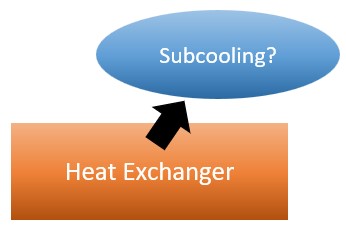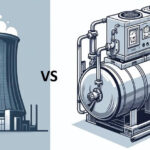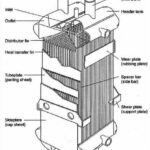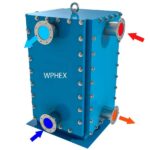Introduction
In the realm of heat exchangers, optimizing efficiency is crucial for achieving optimal performance and energy savings. One effective technique that contributes to improved heat transfer and overall system efficiency is subcooling. In heat exchangers it involves cooling a liquid refrigerant below its saturation temperature. In this article, we will understand the concept, its significance in heat exchangers, and its impact on heat duty. By understanding the principles and benefits of subcooling, engineers and technicians can harness its potential to enhance heat exchanger performance.
So what is it?
It is a process that involves cooling a liquid refrigerant below its saturation temperature, typically after condensation has occurred in a heat exchanger. When a refrigerant undergoes condensation, it transitions from a high-pressure, high-temperature vapor to a high-pressure, low-temperature liquid. However, this liquid still carries some heat energy above its saturation temperature. By subcooling the liquid refrigerant, this excess heat energy is removed, leading to a further decrease in temperature.
The Benefits
In heat exchangers the process offers several notable benefits. Firstly, it enhances heat transfer efficiency by increasing the temperature difference between the refrigerant and the surrounding medium. This greater temperature difference facilitates more efficient heat exchange, resulting in improved performance and energy savings.
Secondly, it helps prevent premature flashing of the liquid refrigerant into vapor. Flashing occurs when the liquid refrigerant enters a region of lower pressure and rapidly vaporizes. By subcooling the refrigerant, the risk of flashing is minimized, ensuring smooth and consistent heat transfer without disruptions.
Additionally, it enables the system to have an increased cooling capacity. By using this process on the refrigerant, its density increases, allowing it to carry more heat energy. This expanded cooling capacity is particularly advantageous in applications that require higher heat removal rates or in systems operating under demanding conditions.
Impact of subcooling on heat exchanger duty
The impact on the heat duty of a heat exchanger depends on the specific operating conditions and design of the system. In general, it can affect the heat duty in the following ways:
- Increased heat removal capacity: using this process on liquid refrigerant enhances the cooling capacity of the heat exchanger. The additional removal of heat energy below the saturation temperature allows for greater heat transfer between the refrigerant and the surrounding medium. As a result, the heat duty of the exchanger can increase since it is capable of transferring more heat.
- Improved temperature difference: it helps to maintain a larger temperature difference between the refrigerant and the surrounding medium in the heat exchanger. A larger temperature difference translates to a higher heat transfer rate according to the principles of heat transfer. Therefore, subcooling can contribute to an increased heat duty by promoting more efficient heat exchange.
- Reduced temperature approach: using the process on a refrigerant can lower the temperature of the liquid entering the heat exchanger. This results in a reduced temperature approach, which is the temperature difference between the fluid entering the heat exchanger and the fluid being cooled. A smaller temperature approach generally leads to a higher heat duty since it allows for more effective heat transfer.
It’s important to note that the impact on the heat duty may also be influenced by other factors such as the heat exchanger design, flow rates, temperature profiles, and the specific properties of the fluids involved. The extent of the impact will vary depending on the specific system and operating conditions.
Calculating heat exchanger duty when subcooling is involved
Consider an example of a refrigeration system with subcooling, where you want to calculate the heat duty of the heat exchanger. Below is a step-by-step approach:
- Determine the properties of the fluids: Identify the properties of both the refrigerant and the fluid being cooled. This includes their specific heat capacities (Cp), mass flow rates (m), and temperature differences (ΔT).
- Calculate the heat transfer rate without subcooling: Use the equation Q = m * Cp * ΔT ;if there is a phase change then the equation will become Q = m * Enthalpy change; to calculate the heat transfer rate between the refrigerant and the fluid being cooled, considering the temperature difference before any subcooling occurs.
- Determine the subcooling temperature: Determine the temperature at which the refrigerant is subcooled. This is typically the temperature at which the liquid refrigerant leaves the subcooling section of the heat exchanger.
- Calculate the heat transfer during subcooling: Determine the temperature difference (ΔTsub) between the subcooling temperature and the temperature of the fluid being cooled. Use the equation Qsub = m * Cp * ΔTsub to calculate the heat transfer rate during subcooling.
- Calculate the total heat transfer rate: Add the heat transfer rate without subcooling (Q) and the heat transfer rate during subcooling (Qsub) to obtain the total heat transfer rate (Qtot = Q + Qsub).
- Adjust for any other heat losses or gains: Consider any additional heat losses or gains that may occur in the system, such as heat transfer through the walls of the heat exchanger or other components. Include these effects in the total heat duty calculation as needed.
It’s important to note that the specific calculations and equations used may vary depending on the system and the properties of the fluids involved. Be sure to use appropriate equations and units for your specific situation
If there is a phase change then the calculation will differ and Qtot = Q (latent heat) + Q(subcooling)
Where;
Q (latent heat) = Mass flow rate * Enthalpy change
Example
The system uses R134a refrigerant, and we want to calculate the heat duty of the heat exchanger.
Given information:
- Mass flow rate of R134a (m): 2 kg/s
- Specific heat capacity of R134a (Cp): 1.15 kJ/kg·K
- Temperature difference before subcooling (ΔT): 10°C
- Temperature difference during subcooling (ΔTsub): 5°C
Step 1: Determine the properties of the fluids.
- R134a:
- Mass flow rate (m): 2 kg/s
- Specific heat capacity (Cp): 1.15 kJ/kg·K
Step 2: Calculate the heat transfer rate without subcooling.
Using the equation Q = m * Cp * ΔT: Q = 2 kg/s * 1.15 kJ/kg·K * 10°C = 23 kJ/s (or 23 kW)
Step 3: Determine the subcooling temperature.
Step 4: Calculate the heat transfer during subcooling.
Using the equation
Qsub = m * Cp * ΔTsub
Qsub = 2 kg/s * 1.15 kJ/kg·K * 5°C = 11.5 kJ/s (or 11.5 kW)
Step 5: Calculate the total heat transfer rate.
Adding the heat transfer rate without subcooling and the heat transfer rate during subcooling:
Qtot = Q + Qsub = 23 kJ/s + 11.5 kJ/s = 34.5 kJ/s (or 34.5 kW)
Therefore, the total heat duty of the heat exchanger in this example is 34.5 kJ/s (or 34.5 kW).
Conclusion
Subcooling plays a vital role in optimizing heat exchanger performance. Using the process on the liquid refrigerant below its saturation temperature, heat transfer efficiency is enhanced, and system capacity is increased. With a thorough understanding of its principles, engineers and technicians can design and operate heat exchangers more effectively, resulting in improved energy efficiency, reduced operational costs, and enhanced overall system performance. Adding this process as a key aspect of heat exchanger design and operation is a valuable strategy for achieving efficient heat transfer and meeting the demands of various industrial applications.
Useful to look at
Heat duty calculator – Software – Android application











